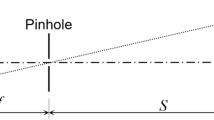Abstract
Three-Dimensional Digital Image Correlation (3D-DIC) is a technique used widely in both academic and industrial settings to measure object morphology, velocity, and full-field strain. However, conventional methods require the use of two synchronized cameras and a lengthy calibration process of taking thirty or more images of specialized target, after which the cameras must be kept fixed. This paper proposes a new approach for obtaining 3D-DIC measurements using only a single camera moved between different positions by a robotic arm, with the extrinsic calibration parameters obtained by manipulation of the internal position and orientation information known to the robot, obviating the need for a calibration target in order to calculate the extrinsic matrix for various positions (after the intrinsic matrix has been established). The specifications of a prototype are presented, and the method is quantitatively and qualitatively compared to the traditional 3D-DIC approach to determine relative accuracy and reliability in shape measurements. By correcting for errors in the reported orientation of the robotic arm, it was possible to achieve the same accuracy as the traditional 3D-DIC approach for stereo angles up to 30o, beyond which the loss of image overlap results in linear increasing errors that are up to an order of magnitude greater. The method is also further extended to allow for images from more than two positions to be combined in a single analysis, which enables an expanded view of up to 360° using only a single camera and without the additional calibrations required by current multi-camera expanded view systems. The integration of this new 3D-DIC approach into future robotic systems will facilitate new capabilities for performing vital tasks, such as material analysis, infrastructure assessment, and human-robot interactions.











Similar content being viewed by others
References
Chu T, Ranson W, Sutton M (1985) Applications of digital-image-correlation techniques to experimental mechanics. Exp Mech 25(3):232–244. https://doi.org/10.1007/bf02325092
Bruck H, McNeill S, Sutton M, Peters W (1989) Digital image correlation using Newton-Raphson method of partial differential correction. Exp Mech 29(3):261–267. https://doi.org/10.1007/bf02321405
Luo PF, Chao YJ, Sutton MA, Peters WH III (1993) Accurate measurement of three-dimensional deformations in deformable and rigid bodies using computer vision. Exp Mech 33(2):123–132. https://doi.org/10.1007/BF02322488
Helm JD, McNeill SR, Sutton MA (1996) Improved three-dimensional image correlation for surface displacement measurement. Opt Eng 35(7):1911–1920. https://doi.org/10.1117/1.600624
Cardenas-Garcia J, Yao H, Zheng S (1995) 3d reconstruction of objects using stereo imaging. Opt Lasers Eng 22(3):193–213. https://doi.org/10.1016/0143-8166(94)00046-D
Sutton MA, Orteu J-J, Schreier HW (2009) Image correlation for shape, motion and deformation measurements, basic concepts, theory and applications. Springer
Genovese K, Casaletto L, Rayas J, Flores V, Martinez A (2013) Stereo-digital image correlation (dic) measurements with a single camera using a biprism. Opt Lasers Eng 51(3):278–285. https://doi.org/10.1016/j.optlaseng.2012.10.001
Yu L, Pan B (2016. [Online]) Single-camera stereo-digital image correlation with a four-mirror adapter: optimized design and validation. Opt Lasers Eng 87:120–128. https://doi.org/10.1016/j.optlaseng.2016.03.014
Lopez-Alba E, Felipe-Seśe L, Schmeer S, Díaz FA (2016) Optical low-cost and portable arrangement for full field 3d displacement measurement using a single camera. Meas Sci Technol 27(11):115901 [Online]. Available: stacks.iop.org/0957-0233/27/i=11/a=115901
Li J, Dan X, Xua W, Wang Y, Yang G, Yang L 3d digital image correlation using single color camera pseudo-stereo system. Opt Laser Technol 95(4):1–7, 2017. https://doi.org/10.1016/j.optlastec.2017.03.030
Zappa E, Hasheminejad N (2017) Digital image correlation technique in dynamic applications on deformable targets. Exp Tech 41:377–387. https://doi.org/10.1007/s40799-017-0184-3
Shao X, Dai X, Chen Z, Dai Y, Dong S, He X (2016) Calibration of stereo-digital image correlation for deformation measurement of large engineering components. Meas Sci Technol 27(12):125010 [Online]. Available: stacks.iop.org/0957-0233/27/i=12/a=125010
Takada Y, Koyama K, Usami T (2014) Position estimation of small robotic fish based on camera information and gyro sensors. Robotics 3:149–162. https://doi.org/10.3390/robotics3020149
Trebuna F, Hunady R, Hagara M, Virgala I (2015) High-speed digital image correlation as a tool for 3d motion analysis of mechanical systems. Am J Mech Eng 3(6):195–200. [Online]. Available: pubs.sciepub.com/ajme/3/6/8
Qi Y (2013) A performance analysis of vision-based robot localization system”, Master’s thesis, Lehigh University
Genovese K, Cortese L, Rossi M, Amodio D (2016) A 360-deg digital image correlation system for materials testing. Opt Lasers Eng 82:127–134
Uyanik C, Ozkan M (2017) A method for determining 3D surface points of objects by a single camera and rotary stage. In: 2017 International Conference on Computer Science and Engineering (UBMK), Antalya, pp 124–129. https://doi.org/10.1109/UBMK.2017.8093580
Nonis C, Niezrecki C, Yu T, Ahmed S, Su C, Schmidt T (2013) Structural health monitoring of bridges using digital image correlation. Proc SPIE-Int Soc Opt Eng 8695. https://doi.org/10.1117/12.2009647
Labvolt robot systems, 5150, Festo Didactic (2017) [Online]. Available: labvolt.com/downloads/datasheet_98-5150-0_en_120V_60Hz.pdf
Transitioning from the fl3-u3-88s2 to the fl3-u3-120s3 camera, 11060, FLIR Machine Vision (2016) [Online]. Available: ptgrey.com/KB/11060
Vic-3d reference manual, 7, Correlated Solutions (2010) [Online]. Available: http://correlatedsolutions.com/installs/Vic-3D-2010-manual.pdf
Canals R, Roussel A, Famechon J, Treuillet S (2002) A biprocessor-oriented vision-based target tracking system. IEEE Trans Ind Electron 49(2):500–506 The final code used for this project is available online at bit.ly/2BAqijm
Author information
Authors and Affiliations
Corresponding author
Rights and permissions
About this article
Cite this article
Khrenov, M., Bruck, H.A. & Gupta, S.K. A Novel Single Camera Robotic Approach for Three-Dimensional Digital Image Correlation with Targetless Extrinsic Calibration and Expanded View Angles. Exp Tech 42, 563–574 (2018). https://doi.org/10.1007/s40799-018-0277-7
Received:
Accepted:
Published:
Issue Date:
DOI: https://doi.org/10.1007/s40799-018-0277-7




